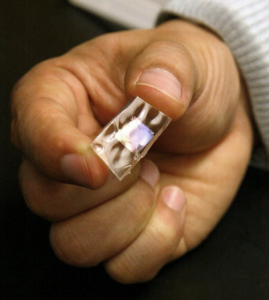A lot of designers have been exploring the idea of garments that can illuminate and change color in an instant based on mood, movement and environmental factors. There are still no practical display solutions for wearable technology aside from some attempts at flexible displays, some clever applications of smart inks and Philip's investment in flexible light fabrics. But this hasn't stopped designers from exploring the possibilities. Here is a collection of projects that change color by covering the surface of the garment with LEDs. Cutecircuit Galaxy Dress Cutecircuit's Galaxy Dress may not be wearable, but it certainly is an engineering achievement. Covered in 10's of thousands of LEDs, this dress subtly shifts color and creates a gorgeous pattern of light across the entire surface. I can't help but wonder how heavy it is and how warm it gets while all the lights are on. Regardless, it's a good exploration about the possibilities.
Hussein Chalayan video dress Similar to the Galaxy Dress, Hussein Chalayan's video dress is made up of thousands of LEDs that cover the surface. He added an outer layer of fabric that defuses the light, which smoothes and softens the effect.
Philips Design Probes: Skin Dress One of Philips Design Probes labeled "Skin" examines the future integration of sensitive materials in the area of emotional sensing. This exploration covers a garment in soft deffused LEDs to illustrate how emotive technology can use pattern and color change to interact and predict the emotional state of the wearer.
A bridal application With all of this illuminated fabrics exploration, we are beginning to see attempts to bring the concepts into real world applications. Brittany Beltz integrated hundreds of LEDs into her wedding gown and surprised the audience by illuminating the garment during her first dance with her new husband.
Katy Perry's Glowing Met Costume Gala Gown (Shown in the above photo) We are also finding illuminated garments find their way into the entertainment and music industry. While attending a red carpet event for the Met Costume Gala, Katie Perry wrapped herself in an illuminated gown created by Cutecircuit. The gown included LED lights that were controlled by a switch that was hidden inside Perry's bra. Read more about this garment at ecouterre.com.
All of these solutions will have non-trivial challenges such as power and heat. Although these explorations are gorgeous, I am still waiting to see a practical application.
Top image from ecouterre.
